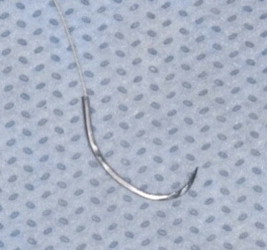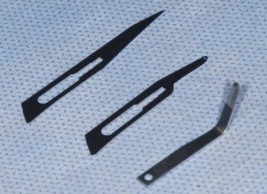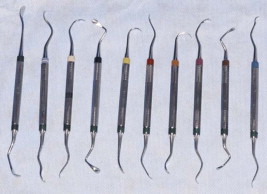History of the Procedure
The diagnosis of cleft lip and palate deformities dates back to ancient times. Archaeological evidence from ancient Schonwerda and Peruvian civilizations describes individuals who lived until adulthood with untreated cleft deformities. Although the diagnosis of cleft lip and palate has existed for centuries, the treatment of such congenital defects has had little development until the modern age. It was during the Chin dynasty, in the fourth century ad , that the first description of surgical correction appears, and it addresses only the cleft lip. Palatal clefts were left surgically unrepaired. Occluding the defect with rolls of cotton or metal plates made of silver or lead was the treatment for the palatal cleft. For many years the only treatment for palatal clefts involved the use of obturators because repair was a technically demanding procedure and adequate anesthesia was lacking.
In 1764 French dentist Le Monnier performed the first surgical repair of a cleft velum. Le Monnier’s technique involved three steps; approximating the cleft edges with suture, cauterizing the cleft edges, and then realigning the fresh edges. The earliest successful repairs of the soft palate were reported by Von Graefe in 1816 and Philibert Roux in 1819. The surgical techniques for cleft palate closure continued to evolve, with further developments contributed by various surgeons, including von Langenbeck in 1859, Veau in 1931, and Kilner and Wardill in 1937. There have been several modifications to the palatoplasty technique from when they were first described. The most popular was described by Bardach in 1967. Most modifications are subtle changes from the originally described surgical techniques.
History of the Procedure
The diagnosis of cleft lip and palate deformities dates back to ancient times. Archaeological evidence from ancient Schonwerda and Peruvian civilizations describes individuals who lived until adulthood with untreated cleft deformities. Although the diagnosis of cleft lip and palate has existed for centuries, the treatment of such congenital defects has had little development until the modern age. It was during the Chin dynasty, in the fourth century ad , that the first description of surgical correction appears, and it addresses only the cleft lip. Palatal clefts were left surgically unrepaired. Occluding the defect with rolls of cotton or metal plates made of silver or lead was the treatment for the palatal cleft. For many years the only treatment for palatal clefts involved the use of obturators because repair was a technically demanding procedure and adequate anesthesia was lacking.
In 1764 French dentist Le Monnier performed the first surgical repair of a cleft velum. Le Monnier’s technique involved three steps; approximating the cleft edges with suture, cauterizing the cleft edges, and then realigning the fresh edges. The earliest successful repairs of the soft palate were reported by Von Graefe in 1816 and Philibert Roux in 1819. The surgical techniques for cleft palate closure continued to evolve, with further developments contributed by various surgeons, including von Langenbeck in 1859, Veau in 1931, and Kilner and Wardill in 1937. There have been several modifications to the palatoplasty technique from when they were first described. The most popular was described by Bardach in 1967. Most modifications are subtle changes from the originally described surgical techniques.
Indications for the Use of the Procedure
The objectives of palatoplasty are the development of normal speech, separation of the oral and nasal cavities, creation of a functional swallowing mechanism, and improvement of eustachian tube function. The velum plays an essential role in all these functions. During speech, the levator palatine muscle elevates the soft palate to occlude on the posterior pharyngeal wall. This posterior movement, along with lateral pharyngeal constriction by the superior constrictor muscle, seals the oral pharynx from the nasal pharynx. Closure directs the flow of air from the larynx out the mouth. Speech is produced with the coordination of the larynx (specifically, the vocal cords), pharyngeal constrictors, velum, tongue, lips, and teeth. The process of speech development is a complex orchestration of muscles and hard and soft tissues that enables communication.
In the case of palatal clefts, the patient is unable to seal the oral pharynx from the nasal pharynx. Large volumes of air escape through the nasal passages, resulting in hypernasal speech, along with a multitude of secondary speech abnormalities. Controversy lingers with regard to the appropriate surgical timing of repair of the palatal cleft. Studies have demonstrated the negative effects of early palatal closure on facial growth. Surgeons and clinicians must balance the benefits of early surgical intervention for improved speech outcomes against the negative effects on facial growth.
An intact velum is equally important for normal swallowing, which prevents nasal food regurgitation. Although nasal regurgitation can be a nuisance, the lack of intelligible speech is extremely detrimental to the patient. Eustachian tube dysfunction is almost universal in patients with cleft palate. The auditory canal is the only direct outlet to the middle ear. Pressure equilibration across the tympanic membrane occurs by this outlet. In patients with cleft palate, both the size and shape of the auditory canal, along with the muscular attachment to the cartilage, are abnormal. As a result, the middle ear is unable to equalize pressure differences across the tympanic membrane. The increase in middle ear pressure results in ear effusions, causing hearing loss. Normal hearing is essential in normal speech development. Middle ear pressure differences are easily corrected with the surgical placement of myringotomy tubes. Patients with cleft palate should be closely followed for middle ear disease. Although all indications are important when treating patients with cleft palate, the development of adequate speech is the central objective in creating normal velar function.
Most centers recommend closure around 8 to 12 months of age, correlating with the time of language skill acquisition. Some surgeons advocate early repair with a two-stage technique. This involves closing the soft palatal cleft at 4 to 6 months and delaying the repair of the hard palate until 15 to 18 months of age, allowing further facial development. Although in theory staged palatal repair appears advantageous, clinical studies have demonstrated a negative effect on speech development, and maxillary growth benefits are questionable. The two-flap palatoplasty technique has an 80% to 90% success rate in obtaining palatal closure without secondary hypernasality.
Limitations and Contraindications
Current techniques in cleft palate closure allow for wide variation in cleft palate formation. The pedicle two-flap technique is the most commonly used flap for correcting palatal clefts. The ability to mobilize the mucosal flaps, obtaining tension-free closure with a reliable vascular supply, allows for closure of most palatal clefts. Limitations of the technique relate to the inability to mobilize tissue adequately to obtain a tension-free closure. When the palatal cleft appears excessively wide or there is an inherent deficiency of palatal tissue, consideration should be given to delaying repair to allow increased growth. Care should be taken when closing wide palatal clefts under excessive tension, which can lead to mucosal dehiscence or complete flap necrosis. Secondary failed palatoplasty repair can prove most challenging and is best avoided.
As are the indications for repair, contraindications to palatoplasty are related to the patient’s ability to maintain adequate ventilation and the development of speech. With patients who have syndromic disorders, tracheostomies, delayed speech development, or mental disabilities, delaying repair should be considered until the patient is able to benefit from velar reconstruction.
Technique: Two-Flap Palatoplasty
Step 1:
Intubation and Setup
The patient is transferred to the operating room table, and general anesthesia is induced. Once an adequate level of anesthesia and intravenous (IV) access has been obtained, the patient is appropriately positioned with the head at the edge of the operating table. A shoulder roll is used to achieve maximal neck extension. The bed is placed in a mild Trendelenburg position to maximize visualization. With the patient correctly positioned, the Dingman mouth retractor is placed in the patient’s mouth for palatal visualization. When the retractor is placed, it is critical to take care not to dislodge or kink the endotracheal tube. Care also must be taken to ensure that the anterior prongs are placed on the alveolar ridge and that the upper lip is not pinched underneath, which would cause damage.
Step 2:
Retractor Placement
Once the Dingman mouth retractor has been positioned, 0.25% Marcaine with 1 : 200,000 epinephrine is injected into the hard and soft palate. This is done before prepping to allow the vasoconstrictor adequate time to take effect. The patient is then prepped, along with the retractor, and surgical drapes are placed, isolating the surgical site.
Step 3:
Incision
Stay updated, free dental videos. Join our Telegram channel

VIDEdental - Online dental courses





